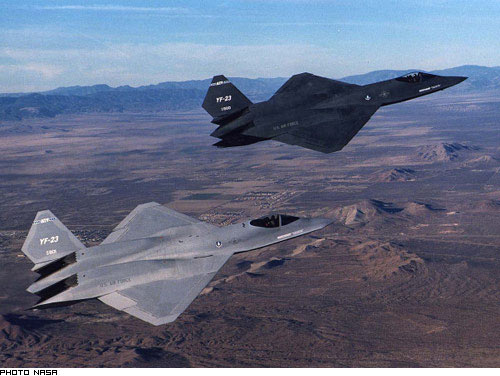Northrop McDonnell Douglas YF-23 Black Widow II
Summary
| Category | Combat aircraft |
| Origin country | 🇺🇸 United States |
| First flight | 27 August 1990 |
| Year of introduction | |
| Number produced | 2 units |
Description
During the 1980s, the US Air Force launched the Advanced Tactical Fighter (ATF) program with the goal of designing a combat aircraft capable of countering new Soviet fighters such as the Flanker and the MiG-29, which posed a threat to American fighters like the F-15E Strike Eagle.
Two aircraft manufacturers were selected for this competition: Lockheed with its prototype YF-22, and Northrop McDonnell Douglas with the YF-23, featuring a revolutionary design. The YF-23's design was unlike any other existing aircraft, with a very streamlined fuselage, wide tail fins angled at 45°, and perfectly triangular wings. The cockpit, reminiscent of the SR-71 Blackbird, was carefully integrated into the rest of the fuselage, with an emphasis on stealth. However, unlike the recommendations made by the US Air Force, the YF-23 did not feature thrust vectoring due to excessive weight. Similar to the YF-22, the armament was carried internally in the fuselage, and a 20mm Vulcan M61 cannon was also mounted on the aircraft.
Northrop assembled two examples of the YF-23. The first, named PAV-1 (Prototype Air Vehicle), was equipped with two Pratt & Whitney YF-119 engines, while the PAV-2 was powered by General Electric YF-120 engines. The first YF-23 (PAV-1) was publicly presented at Edwards on June 22, 1990. Subsequent taxi tests revealed shimmy problems with the landing gear. On August 27, 1990, the YF-23 took off for its first 20-minute flight, which proceeded without major issues. From takeoff, the aircraft demonstrated the power of its new engines, prompting the accompanying F-15 and F-16 "chase planes" to engage their afterburners just to keep up. Three days later, the YF-23 embarked on a second flight, but it was interrupted by problems with the engines, which emitted black smoke. Nevertheless, the testing schedule was adhered to. On September 18, it achieved Mach 1.43 in supercruise. The PAV-2 made its maiden flight on October 27, 1990, with Jim Sandberg at the controls. Few differences were noted compared to the PAV-1 prototype.
The competition for the ATF was eventually won by the Lockheed YF-22, later renamed the F-22 Raptor. While the exact reasons for this decision remain confidential, it appears that the YF-23 was stealthier and faster than its competitor, but the YF-22 offered easier and less expensive production prospects as well as potential for future development. Different approaches were taken by the two aircraft manufacturers: Lockheed's main objective was the operational characteristics of its aircraft, aiming to produce a versatile combat aircraft. In contrast, Northrop prioritized the aircraft's stealth, sacrificing some versatility.
The YF-23's final sortie took place on December 18. The two YF-23 prototypes accumulated 65 flight hours over 50 sorties. The YF-22, on the other hand, completed 74 sorties and logged 91 flight hours. The YF-23 did not receive an official name, but it was unofficially referred to as the "Black Widow II," in reference to Northrop's WWII night fighter, the P-61 Black Widow. PAV-1 was reportedly nicknamed the "Gray Ghost," while PAV-2 was called the "Spider." Its 34th and final flight occurred on November 30, 1990.
Technical specifications
| Version: McDonnell Douglas-Northrop YF-23A | |
|---|---|
| Crew | 1 pilot |
| Operational range | 1482 km (921 mi) |
| Maximum speed | 2655 km/h (1650 mph) |
| Wing area | 84 m² (904.2 sqft) |
| Wingspan | 13.3 m (43.7 ft) |
| Height | 4 m (13.1 ft) |
| Length | 20.6 m (67.5 ft) |
| Service ceiling | 19812 m (65000 ft) |
| Empty weight | 13154 kg (29000 lbs) |
| Max. takeoff weight | 28123 kg (62001 lbs) |
| Powerplant | 2 × turbojets General Electric YF120 delivering 15876 kgp |
| Ejection seat | McDonnell Douglas ACES II |
Current operating countries
No country is operating the YF-23 Black Widow II in 2025.
All operators
Photo of YF-23 Black Widow II
